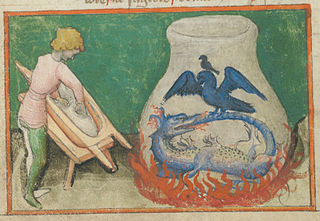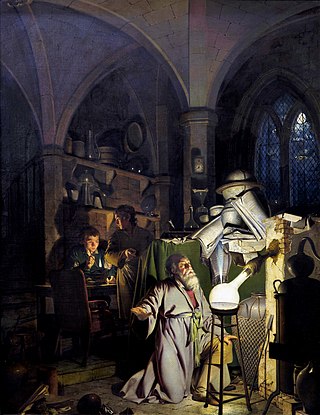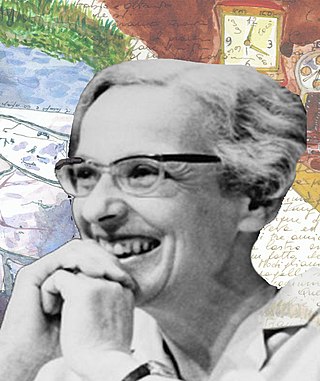Related Research Articles

Alchemy is an ancient branch of natural philosophy, a philosophical and protoscientific tradition that was historically practiced in China, India, the Muslim world, and Europe. In its Western form, alchemy is first attested in a number of pseudepigraphical texts written in Greco-Roman Egypt during the first few centuries AD.

Carl Gustav Jung was a Swiss psychiatrist and psychoanalyst who founded analytical psychology. Jung's work has been influential in the fields of psychiatry, anthropology, archaeology, literature, philosophy, psychology, and religious studies. He worked as a research scientist at the Burghölzli psychiatric hospital, in Zurich, under Eugen Bleuler. Jung established himself as an influential mind of his time, developing a friendship with Sigmund Freud, founder of psychoanalysis, conducting a lengthy correspondence, paramount to their joint vision of human psychology. He is regarded as one of the most influential psychologists in history.
Collective unconscious refers to the unconscious mind and shared mental concepts. It is generally associated with idealism and was coined by Carl Jung. According to Jung, the human collective unconscious is populated by instincts, as well as by archetypes: ancient primal symbols such as The Great Mother, the Wise Old Man, the Shadow, the Tower, Water, and the Tree of Life. Jung considered the collective unconscious to underpin and surround the unconscious mind, distinguishing it from the personal unconscious of Freudian psychoanalysis. He believed that the concept of the collective unconscious helps to explain why similar themes occur in mythologies around the world. He argued that the collective unconscious had a profound influence on the lives of individuals, who lived out its symbols and clothed them in meaning through their experiences. The psychotherapeutic practice of analytical psychology revolves around examining the patient's relationship to the collective unconscious.

The philosopher's stone, or more properly philosophers' stone, is a mythic alchemical substance capable of turning base metals such as mercury into gold or silver. It is also called the elixir of life, useful for rejuvenation and for achieving immortality; for many centuries, it was the most sought-after goal in alchemy. The philosopher's stone was the central symbol of the mystical terminology of alchemy, symbolizing perfection at its finest, enlightenment, and heavenly bliss. Efforts to discover the philosopher's stone were known as the Magnum Opus.
In analytical psychology, the shadow is an unconscious aspect of the personality that does not correspond with the ego ideal, leading the ego to resist and project the shadow. In short, the shadow is the self's emotional blind spot, projected ; e.g., trickster.

Marie-Louise von Franz was a Swiss Jungian psychologist and scholar, known for her psychological interpretations of fairy tales and of alchemical manuscripts.
The anima and animus are a syzygy of dualistic, Jungian archetypes among the array of other animistic parts within the Self in Jungian psychology, described in analytical psychology and archetypal psychology, under the umbrella of transpersonal psychology. The Jungian parts of the Self are a priori part of the infinite set of archetypes within the collective unconscious. Modern Jungian clinical theory under the analytical/archetypal -psych framework considers a syzygy-without-its-partner like yin without yang: countertransference reveals that logos and/or eros are in need of repair through a psychopomp, mediating the identified patient's Self; this theoretical model is similar to positive psychology's understanding of a well-tuned personality through something like a Goldilocks principle.
In alchemy, nigredo, or blackness, means putrefaction or decomposition. Many alchemists believed that as a first step in the pathway to the philosopher's stone, all alchemical ingredients had to be cleansed and cooked extensively to a uniform black matter.

The Self in Jungian psychology is a dynamic concept which has undergone numerous modifications since it was first conceptualised as one of the Jungian archetypes.

Rubedo is a Latin word meaning "redness" that was adopted by alchemists to define the fourth and final major stage in their magnum opus. Both gold and the philosopher's stone were associated with the color red, as rubedo signaled alchemical success, and the end of the great work. Rubedo is also known by the Greek word iosis.

In alchemy, albedo, or leucosis, is the second of the four major stages of the Magnum Opus, along with nigredo, citrinitas and rubedo. It is a Latinicized term meaning "whiteness". Following the chaos or massa confusa of the nigredo stage, the alchemist undertakes a purification in albedo, which is literally referred to as ablutio – the washing away of impurities. This phase is concerned with "bringing light and clarity to the prima materia ".
Psychology and Alchemy, volume 12 in The Collected Works of C. G. Jung, is Carl Jung's study of the analogies between alchemy, Christian dogma, and psychological symbolism.
Jungian archetypes are a concept from psychology that refers to a universal, inherited idea, pattern of thought, or image that is present in the collective unconscious of all human beings. The psychic counterpart of instinct, archetypes are thought to be the basis of many of the common themes and symbols that appear in stories, myths, and dreams across different cultures and societies. Some examples of archetypes include those of the mother, the child, the trickster, and the flood, among others. The concept of archetypes and the collective unconscious was first proposed by Carl Jung, a Swiss psychiatrist and psychoanalyst.
Archetypal pedagogy is a theory of education developed by Clifford Mayes that aims at enhancing psycho-spiritual growth in both the teacher and student. The idea of archetypal pedagogy stems from the Jungian tradition and is directly related to analytical psychology.
The following outline is provided as an overview of and topical guide to alchemy:
In Jungian psychology, the Wise Old Woman and the Wise Old Man are archetypes of the collective unconscious.

The Great Work is an alchemical term for the process of working with the prima materia to create the philosopher's stone. It has been used to describe personal and spiritual transmutation in the Hermetic tradition, attached to laboratory processes and chemical color changes, used as a model for the individuation process, and as a device in art and literature. The magnum opus has been carried forward in New Age and neo-Hermetic movements which sometimes attached new symbolism and significance to the processes. The original process philosophy has four stages:

What a Piece of Work is a 1999 verse novel by Australian poet Dorothy Porter which was shortlisted for the 2000 Miles Franklin Award.

Stanton Marlan, Ph.D., ABPP, FABP is an American clinical psychologist, Jungian psychoanalyst, author, and educator. Marlan has authored or edited scores of publications in Analytical Psychology and Archetypal Psychology. Three of his more well-known publications are The Black Sun. The Alchemy and Art of Darkness, C. G. Jung and the Alchemical Imagination, and Jung's Alchemical Philosophy. Marlan is also known for his polemics with German Jungian psychoanalyst Wolfgang Giegerich. Marlan co-founded the Pittsburgh Society of Jungian Analysts and was the first director and training coordinator of the C. G. Jung Institute Analyst Training Program of Pittsburgh. Currently, Marlan is in private practice and serves as adjunct professor of Clinical Psychology at Duquesne University, Pittsburgh, Pennsylvania, USA.
References
- Nigel Hamilton (1985), The Alchemical Process of Transformation
- C. G. Jung, Psychology and Alchemy 2nd. ed. (Transl. by R. F. C. Hull)
- E. J. Holmyard, Alchemy New York. Dower Publications. 1990